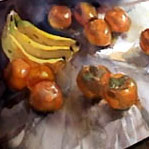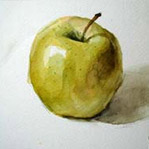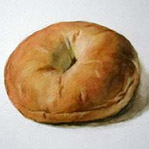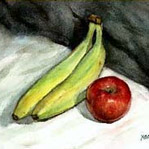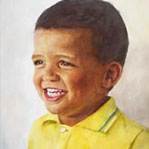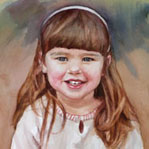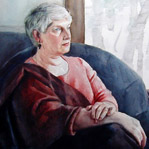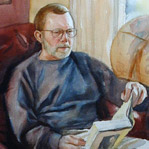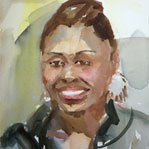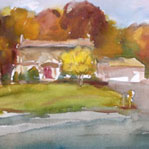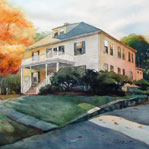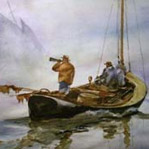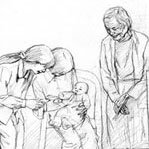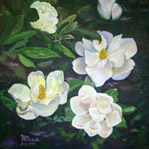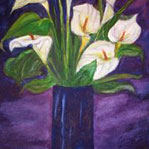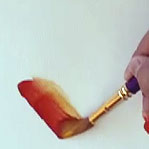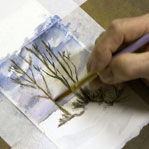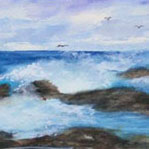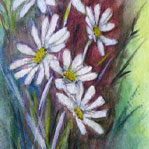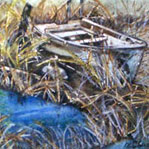Step-by-Step Tutorials
These are step-by-step watercolor tutorials using a picture-text format to illustrate the process of a painting going from an idea to completion. Each lesson is arranged so that you can easily save it to your computer. Please feel free to share them.
Still-lifes in Watercolor
|
View information on brushes Every successful painting begins with significant time spent on the composition. Once I pick up my brush, I first focus on laying out the main objects. Using yellow and red colors for the fruit, I then introduce blue into my palette to create a cooler, darker color for the background as well as for the shadows and shading, and I intentionally leave white areas which will be highlights and spaces for details... |
|
|
View information on brushes This is a demonstration on how to capture the light and shadow of a green apple, and the importance of identifying values in a painting, as well as using layering to create a three-dimensional form. |
|
|
View information on brushes Bagels have a soft surface. I will demonstrate how to capture the feel of the surface of a bagel, the color, and the very fine details necessary to reveal this bread’s nature by using glazing and lifting-off techniques. |
|
|
View information on brushes In this demonstration, you will learn how to arrange a still-life with multiple objects in a pleasing manner. In a still-life, the composition is as important as the value study. Here, there are two different kinds of objects and they need to be set in a pleasing arrangement in one setting. The difference in colors, values, and texture in the two different fruits will add a new challenge to the painting. |
Watercolor Portraits
|
View information on brushes The key to a successful portrait painting is producing a good composition, starting the painting by moving from the bigger shapes, then working on smaller and smaller shapes, then finally not getting lost in the details too early in the process. Instead, concentrate on the overall painting and pay attention to the color temperature and balance... |
|
|
View information on brushes For a portrait painting, I usually begin with a thumbnail study. This is the step where I plan the composition, sort out perspective and relationships, proportion and balance, and size and distance. A good drawing is a good base for a painting; it can give you more confidence, so take as much time as you need in this step... |
|
|
View information on brushes When painting a portrait, it is most important to get to know the subject. To do this, I visited her in her home in order to understand her family, her personality, and listen to her stories... |
|
|
View information on brushes In this watercolor demonstration, you will learn the process of moving from an idea to the completion of a watercolor portrait, starting from a few preliminary drawings and a number of high-resolution digital photographs to completion in the studio. |
|
|
View information on brushes A professional portrait can take days to complete, but there are occasions when you have little time to capture your subject. Here’s how to do it quickly. This study was completed in just 20 minutes... |
Watercolor Landscapes and Seascapes
|
View information on brushes A color study is the process where experimental color composition and value arrangement is done. After that, you would determine your final composition before beginning painting. Color studies are especially useful when you are combining two or more references for a painting. In a recent home portrait commission, my reference pictures included two photographs of maple trees and a picture of the house taken early in the morning... |
|
|
View information on brushes It was late in the summer when I received a commission to do watercolor paintings of a series of homes in the area. As I worked on the project from August through November, I found that I not only enjoyed capturing the detail of these structures on paper, but was also enchanted by the beauty of their surroundings. The gorgeous colors of the trees in the fall would create drama and interest that only enriched my final rendering... |
|
|
View information on brushes (This step by step watercolor lesson is provided by Mary Churchill) A seascape is a very popular subject for watercolor paintings. This reference depicts a fishing boat with the men blowing the foghorn, giving the opportunity to learn to paint fog as well as the ocean. |
Children's Book Illustration
|
Yong Chen is both an author and an illustrator of children’s books. Here he showcases his process of creating fitting illustrations for another author’s manuscript. The book was "Finding Joy," a story that tells of a family going through the adoption of a child from overseas. The first step in the process, naturally, is to read the story. |
Flowers in Watercolor
|
View information on brushes (This step by step watercolor lesson is provided by Mary Churchill) The soft, fragrant flowers of the gardenia plant are complemented by its bright, shiny leaves. I want to capture the subtle colors in the white petals created by both the surrounding green leaves and the deep yellow corolla at its center. |
|
|
View information on brushes (This watercolor lesson is provided by Mary Churchill) Painting cut flowers requires special attention to the flower arrangement, the colors in the vase and background, as well as the direction of your light source. If this is a painting you will use to enter an exhibition, you will also need to be planning matting and framing... |
|
|
View information on brushes My friend, Mary Churchill, has talked about a special brushwork technique used in her paintings. It is a rendering style created with the blending of two colors together on the same brush. Using a round brush, a beautiful blend of colors--from red to orange to yellow--can be created with one stroke... |
Watercolor Gift Cards
|
View information on brushes (This lesson is provided by Mary Churchill) Christmas is a wonderful time of year. Everyone seems to be infected with the spirit of the season. One of the lovely traditions of this season is the exchange of greeting cards with friends and family. Sending original, hand-painted cards shows the recipient that you care. |
|
|
View information on brushes (This lesson is provided by Mary Churchill) Whether it is a birthday card, get-well-soon card, or just a friendly “hello”, the sea is a pleasant inspiration for an original greeting card. This painting includes water, rocks, and waves. It has been made easier to paint by using gouache (Permanent White) for the ocean waves ... |
|
|
View information on brushes (This lesson is provided by Mary Churchill) A cluster of daisies creates a nice hand-made gift card. Here, you will find detailed instructions on what to purchase to make this a nice addition to a birthday party, bridal shower, or to a baby shower. |
|
|
View information on brushes (This lesson is provided by Mary Churchill) I found my subject--a skiff caught in a tangle of reeds--a challenge to paint; therefore, I used masking fluid to draw the reeds. After the mask dried, I painted the negative areas. I painted a few layers and then let them dry in between applications. Next, I removed the mask and painted the positive areas... |


